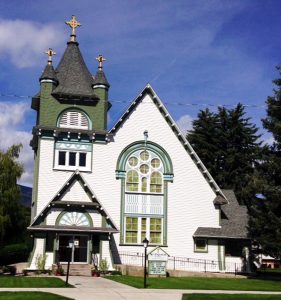
Ten property owners in the neighborhood of the St. Francis of Assisi Catholic Church, located at 411 South 5th Street in Hamilton, have filed a lawsuit challenging the decision by the City of Hamilton Board of Adjustments to grant several variances that would allow the demolition of the existing historic structure and its replacement with a new church building. The existing church was originally constructed in 1897 and represents one of the oldest wood framed Catholic structures in Montana, 122 years old.
The Board of Adjustments approved the conditional use permit and request for variances on a 4 to 2 vote at a meeting held on December 26, 2018. The application was submitted by the St. Francis Church Building Committee and the Diocese of Helena.
In the project narrative, it states that the new structure being proposed is designed to respect the historic character of the existing church, while providing worship space for over 400, an increase of approximately 150 seats. The new church will also provide additional building entrances, all on-grade, to enhance building accessibility. Site improvements include improved on-site parking, improving on-street parking, and installing curb and gutter on the surrounding city block owned by the church. The current design provides a new church structure of approximately 8400 square feet on the main level. The total seating capacity of the sanctuary is 442 occupants; this includes the choir space with 20 dedicated seats.
It states in the application that aesthetically, the new church is intended to replicate the existing church, albeit in its new larger form. The upper elements of the existing bell tower on the southeast corner of the existing church will be salvaged, refurbished and reinstalled on the new structure. The exterior wall treatment will be replicated with similar siding material. The exterior wall trim and detailing will be replicated. The existing sanctuary windows will be reconfigured to allow for the addition of stained-glass windows to be installed in all primary window locations.
The new parking lot design provides for a total of 59 standard parking stalls and six handicapped-accessible parking stalls. In addition to the on-site parking, the applicants agreed to improve on-street parking surrounding the block owned by the church. These improvements will include new curb, pavement and sidewalks along Ravalli Street, South 6th Street and Madison Street. Improvements along South 5th Street will include striping to better define the 60-degree angled parking as well as defining the two existing on-street handicap-accessible stalls.
The Hamilton Zoning Board of Adjustments approved the conditional use permit to build the new building in a Residential Services District “because there is already an existing use as a church, and that the applicant demonstrated a hardship to the property because of the constraint of the size and of the lot and growing constituency.”
The Board approved the variance requests to allow the adjacent on-street parking stalls as part of the required total. It allowed adjustments to the front and rear yard setbacks and allowed an accessory garage to be constructed with a zero lot-line. It also allowed the proposed new church construction to exceed the maximum height requirement in a Residential Services (RS) District.
But the approval also came with the conditions that off-site improvements be made to 5th Street, Ravalli Street, 6th Street, and Madison Street; including curb, gutter, sidewalk, paving and storm drainage to meet current public works standards and ADA accessibility guidelines. These improvements are proposed to provide sixty-eight parking spaces bringing the total improved parking to one-hundred-thirty-three (133) spaces. Ravalli Street is to be improved in coordination with WGM’s Ravalli Street final design plans and approved by Public Works prior to construction. The diocese is also required to provide additional public access easement to accommodate the offset in alley traffic behind the proposed new building, also to be approved by Public Works Director Donny Ramer prior to recording.
The group of 10 homeowners in the neighborhood who filed the lawsuit claim that the Board of Adjustments approved the permit and variances with the absence of findings in the City staff report that the recommendation was not unanimous and that two of the staff members did oppose the project because it was “too big for the current space and out of character for the neighborhood by virtue of the increased size.” They claim the Board abused its discretion by not using the standard of overview outlined in municipal code.
The litigants contend that the board has been negligent and acted in contravention to the law by “not subjecting the church’s justification for doubled capacity to reasonable scrutiny, and arbitrarily and highhandedly ignoring the public interest in the face of manifest concern and resistance by the community. There is no data-supported need for a larger church.” They note that several reasons put forth by the church for needing more capacity involve mere speculation, such as the notion that Stevensville may sometime in the future lose its priest.
“In any case, even if the congregation were growing rapidly, there can be no justification for siting a megachurch that serves the wider valley in the middle of a residential neighborhood in the City of Hamilton,” it states in the lawsuit. They suggest the church consider relocating into the county.
“Allowing the church to double its capacity by approving front and rear setbacks, increasing the height of the building and doubling the parking is detrimental to the health, safety, comfort and general welfare of persons residing in the neighborhood,” they claim.
Besides questioning the church’s hardship claim, the plaintiffs also contend that the permit and variances must also be in the public interest and the public’s interest was either not properly considered or was unjustly ignored in this case.
The case was filed in Ravalli County District Court and Judge Jeffrey Langton will preside.